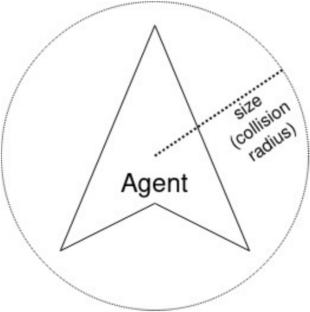Abstract
Swarm robotics describes the coordination among multiple robots assigned to perform a single task collectively and work as a system. The system is usually used in search and-rescue missions in adverse natural environments. Research in this field involves testing theories and algorithms by using physical robots which requires expensive environment setup. This study presents a novel no-code simulation framework for swarm robotics. The software framework provides a set of building block of various components to customize the research and development process. Besides the various platforms that exist nowadays, this proposed framework overcomes the common problem of low flexibility in modeling, resulting significant improvements in the development of any simulation through customization of algorithms and multi-agent modeling. For rapid development of simulation instances, this study proposes a swarm simulation framework that allows multi-agent modeling in a no-code development environment by defining the number of agents and the behaviors they are expected to exhibit. A random environment is generated where the agents and specific target is defined to test swarm robots for search and rescue operations. The framework mainly proposes a no-code environment and provides the opportunity to test the swarm behavior and relevant theories with flexibilities to make necessary adjustments.











Similar content being viewed by others
Data availability
Not applicable.
Notes
A toolkit featured under ‘Unity’, that developers can use to construct elaborate projects with limited or no coding efforts.
References
Beni G, Wang J (1993) Swarm intelligence in cellular robotic systems. In: Ddd V (ed) Robots and biological systems: towards a new bionics? Springer, Berlin, pp 703–712
Choutri K, Lagha M, Dala L (2021) A fully autonomous search and rescue system using quadrotor UAV. Int J Comput Digit Syst 10:2–12
de Alcantara Andrade FA, ReinierHovenburg A, Netto de Lima L, Dahlin Rodin C, Johansen TA, Storvold R, MoraesCorreia CA, Barreto Haddad D (2019) Autonomous unmanned aerial vehicles in search and rescue missions using real-time cooperative model predictive control. Sensors 19(19):4067
Gerkey B, Vaughan RT, Howard A et al (2003) The player/stage project: tools for multi-robot and distributed sensor systems. In: Proceedings of the 11th international conference on advanced robotics, vol 1. Citeseer, pp 317–323
Koenig N, Howard A (2004) Design and use paradigms for Gazebo, an opensource multi-robot simulator. In: 2004 IEEE/rsj international conference on intelligent robots and systems (IROS) (IEEE Cat. No. 04CH37566), vol 3. IEEE, pp 2149–2154
Le B-S, Dang V-L, Bui T-T Swarm robotics simulation using unity. Faculty of Electronics and Telecommunications, University of Science, VNU-HCM, Vietnam
Alfeo AL, Cimino MG, De Francesco N, Lega M, Vaglini G (2018) Design and simulation of the emergent behavior of small drones swarming for distributed target localization. J Comput Sci 29:19–33
Pinciroli C, Trianni V, O’Grady R, Pini G, Brutschy A, Brambilla M, Mathews N, Ferrante E, Di Caro G, Ducatelle F et al (2012) Argos: a modular, parallel, multi-engine simulator for multi-robot systems. Swarm Intell 6(4):271–295
Venkatasivarambabu P, Agrawal R (2024) Enhancing UAV navigation with dynamic programming and hybrid probabilistic route mapping: an improved dynamic window approach. Int J Inf Technol 16(2):1023–1032
Singha AK, Zubair S (2024) Combination of optimization methods in a multi stage approach for a deep neural network model. Int J Inf Technol 16(3):1855–1861
Grasso P, Innocente MS (2022) Stigmergy-based collision–avoidance algorithm for self-organising swarms. In: Computational vision and bio-inspired computing: proceedings of ICCVBIC 2021. Springer, pp 253–261
Arora G, Chauhan P, Emadifar H, Khademi M (2023) Numerical simulation of burger’s equation using a particle swarm optimization. Int J Inf Technol 1–8
Raghav YY, Vyas V (2023) Acbso: a hybrid solution for load balancing using ant colony and bird swarm optimization algorithms. Int J Inf Technol 15(5):2847–2857
Agarwal S, Muppalaneni NB (2022) Portfolio optimization in stocks using mean–variance optimization and the efficient frontier. Int J Inf Technol 14(6):2917–2926
Author information
Authors and Affiliations
Corresponding author
Rights and permissions
Springer Nature or its licensor (e.g. a society or other partner) holds exclusive rights to this article under a publishing agreement with the author(s) or other rightsholder(s); author self-archiving of the accepted manuscript version of this article is solely governed by the terms of such publishing agreement and applicable law.
About this article
Cite this article
Hasan, I., Islam, R., Sharmin, N. et al. A no-code swarm simulation framework for agent-based modeling using nature-inspired algorithms. Int. j. inf. tecnol. (2024). https://doi.org/10.1007/s41870-024-01910-1
Received:
Accepted:
Published:
DOI: https://doi.org/10.1007/s41870-024-01910-1




